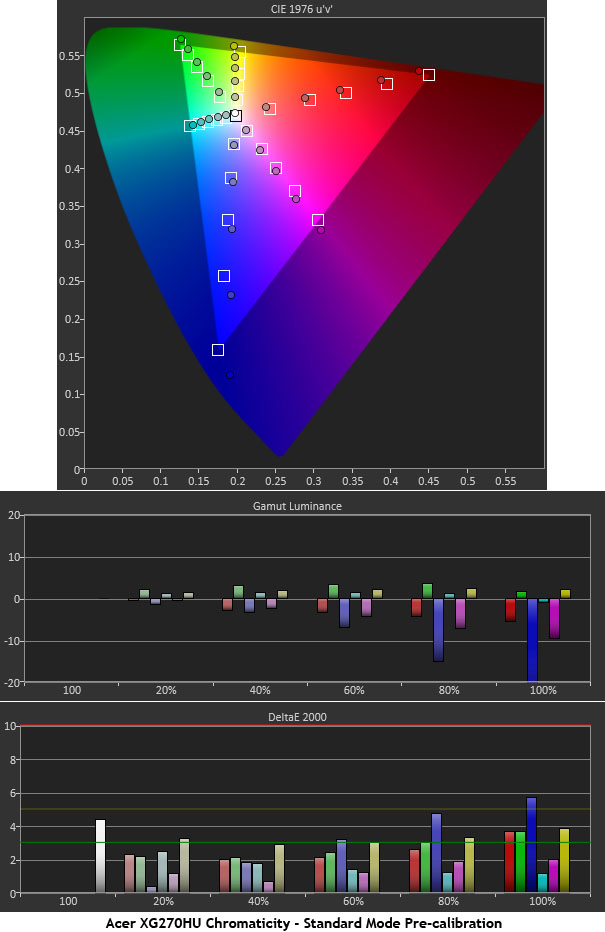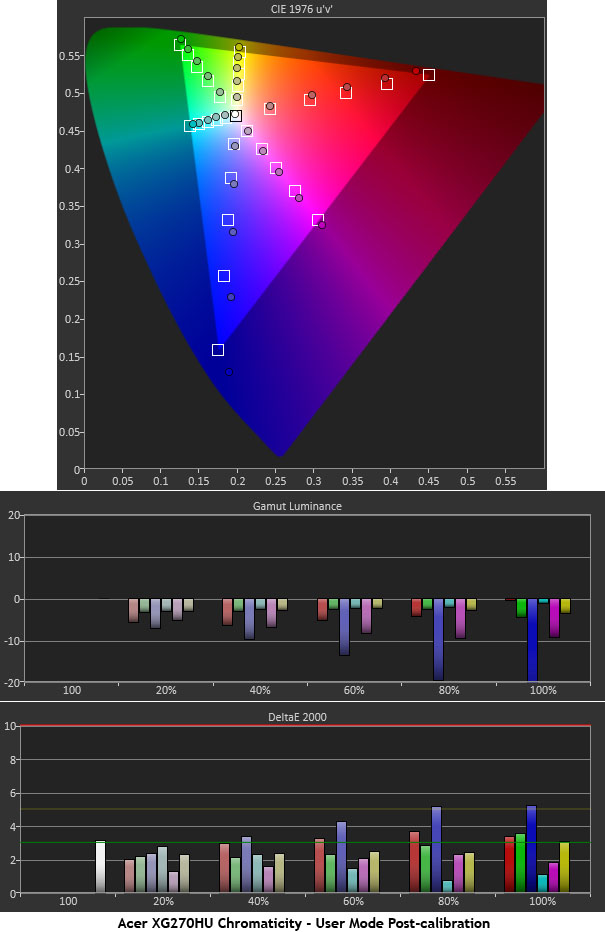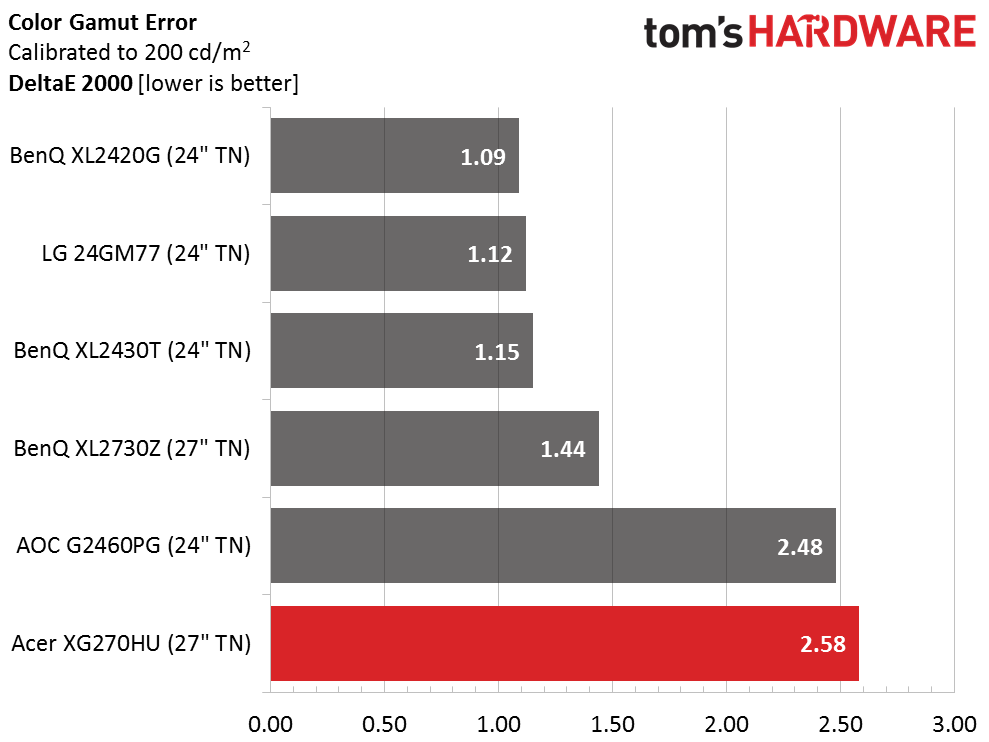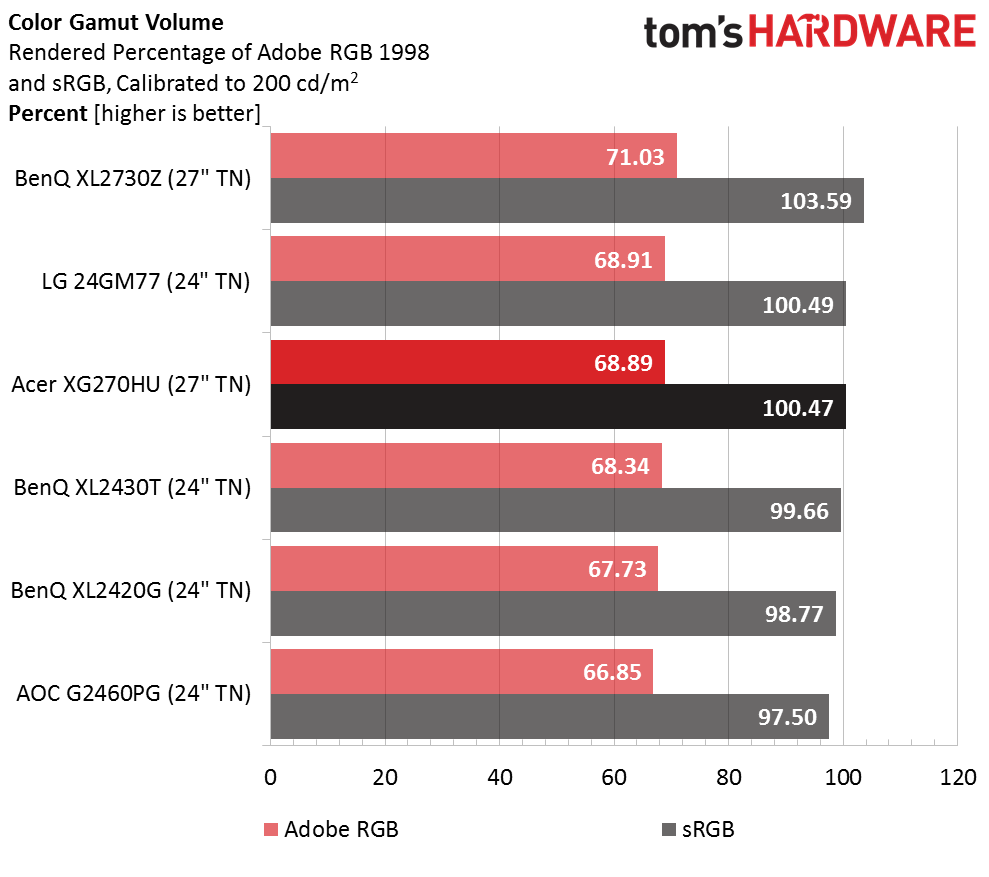Acer XG270HU 27-inch FreeSync Monitor Review
We’ve had G-Sync monitors for many months now, but AMD fans had to wait for FreeSync screens. Today we’re looking at Acer’s 27-inch QHD XG270HU.
Why you can trust Tom's Hardware
Color Gamut And Performance
For details on our color gamut testing and volume calculations, please click here.
There’s really nothing to complain about in the XG270HU’s Standard mode. Green and cyan are pretty much on-target. Yellow has good saturation and is slightly skewed towards green (an error we could see). Red, magenta and blue show both hue and saturation errors, but they aren’t off by much. Blue is the most over-saturated. Since it’s also of lower luminance, though, the end result is alright with a max error of 5.76dE at the 100 percent blue mark. The average error is 2.54 dE, which is quite low.
After calibrating the grayscale and making small changes in the six-axis controls, we got a slightly better-looking chart. But now the average error is 2.58 dE. We prefer the calibrated result because luminances are better balanced with each other and the hue errors in yellow and magenta are no more. The difference you'll see is extremely small though, and we expect most users will be perfectly satisfied with the XG270HU’s color uncalibrated.
Now we return to the comparison group:
The main reason for the Acer’s last-place finish is the over-saturated blue primary. Even though it’s properly compensated for in luminance, it tweaks the overall error up a bit. Still, we’re still perfectly happy with this screen for gaming and most computing tasks. It’s not quite up to the level of a professional monitor but it doesn’t cost as much either.
Gamut Volume: Adobe RGB 1998 And sRGB
If you’re looking for a perfect 100 percent sRGB monitor, the XG270HU and XL2430T come about as close as you can get. While the red primary is slightly under-saturated, blue and magenta wind up outside the gamut triangle making up the extra volume. Since color luminance is also where it should be, the overall result is a monitor that could be considered for some color-critical applications.
Get Tom's Hardware's best news and in-depth reviews, straight to your inbox.
Current page: Color Gamut And Performance
Prev Page Grayscale Tracking And Gamma Response Next Page Viewing Angles, Uniformity, Response And Lag
Christian Eberle is a Contributing Editor for Tom's Hardware US. He's a veteran reviewer of A/V equipment, specializing in monitors. Christian began his obsession with tech when he built his first PC in 1991, a 286 running DOS 3.0 at a blazing 12MHz. In 2006, he undertook training from the Imaging Science Foundation in video calibration and testing and thus started a passion for precise imaging that persists to this day. He is also a professional musician with a degree from the New England Conservatory as a classical bassoonist which he used to good effect as a performer with the West Point Army Band from 1987 to 2013. He enjoys watching movies and listening to high-end audio in his custom-built home theater and can be seen riding trails near his home on a race-ready ICE VTX recumbent trike. Christian enjoys the endless summer in Florida where he lives with his wife and Chihuahua and plays with orchestras around the state.
-
rdc85 Look goods,Reply
hope they can make 144hz IPS "Freesync" monitor...
24" preferred.. 27" just to big for me.. -
eklipz330 "In the case of the XG270HU, its frame rate range is 30-144Hz, which means you can benefit from FreeSync down to 30 FPS."Reply
my god that is wonderful -
ubercake Reply"In the case of the XG270HU, its frame rate range is 30-144Hz, which means you can benefit from FreeSync down to 30 FPS."
The first freesync monitor with such a range. This is great for competition!!!
my god that is wonderful
I also like the fact these freesync monitors are not limited to a single DP input.
Now I feel like I have a choice again. AMD corrected their FCAT issues I had been complaining about for years and now freesync? I may head back to team red with the next gen. This is good stuff. How are the drivers lately? -
wtfxxxgp Very sexy monitor. That IPS version is also supposed to be QHD... That's going to be pricey for sure, but at least it's the start of good things to comeReply
-
wtfxxxgp ReplyLook goods,
hope they can make 144hz IPS "Freesync" monitor...
24" preferred.. 27" just to big for me..
Seriously? 27" 1440p is the SWEET SPOT. -
UncleVesper Reply"In the case of the XG270HU, its frame rate range is 30-144Hz, which means you can benefit from FreeSync down to 30 FPS."
my god that is wonderful
It figures Tom's Hardware does not actually do a full review of their products. The FreeSync range they just took for granted in what they were told. According to GURU3D, they experienced tearing this monitor < 40 FPS, so the minimum range is NOT 30 but 40 HZ.
http://www.guru3d.com/articles_pages/amd_freesync_review_with_the_acer_xb270hu_monitor,12.html -
UncleVesper Link cut off, this was the conclusion: "We did noticed on the ACER screen that at low sub 35 FPS screen tearing was back, which was disappointing. From what we learned, the ACER dynamic range starts at 40Hz, and thus so will FreeSync. If you cannot achieve such a framerate then you need to tweak image quality in such a manner that it stays above the minimum dynamic range. But FreeSync at 40+ FPS is as good as it is at 60 FPS, that is a fact."Reply -
Wisecracker Reply16039451 said:"In the case of the XG270HU, its frame rate range is 30-144Hz, which means you can benefit from FreeSync down to 30 FPS."
my god that is wonderful
Yup.
The first OEMs to seriously target entry-level and 'mainstream' 30Hz+ at a respectable size and resolution are sitting on gold mines. Hopefully, it will happen sooner rather than later.
If Intel gets behind it, it's a done deal. Being the big dog with DX12 on the immediate horizon, and with their investment made into integrated graphics, it is a natural extension to bring DP to great, inexpensive motherboards.
I'd love to see some gaming reviews at the lower-end. Let us see the experience with a $130 APU.
-
singemagique ReplyVery sexy monitor. That IPS version is also supposed to be QHD... That's going to be pricey for sure, but at least it's the start of good things to come
Yep, the XB270HU is 1440p, IPS, 144hz, 4ms, GSync. I picked up two last month from Amazon at $738. They are excellent panels and the best monitors I have used outside of professional monitors. -
quilciri Why, oh why, oh why doesn't it have a VESA mount? You were so close to the perfect monitor, Acer.Reply



